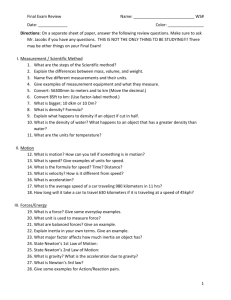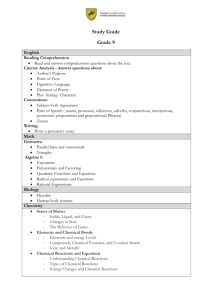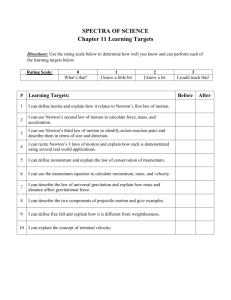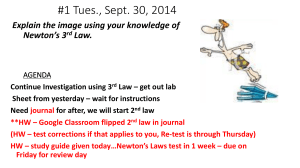Semester 1 Accelerated Exam Study Guide Complete the following
advertisement
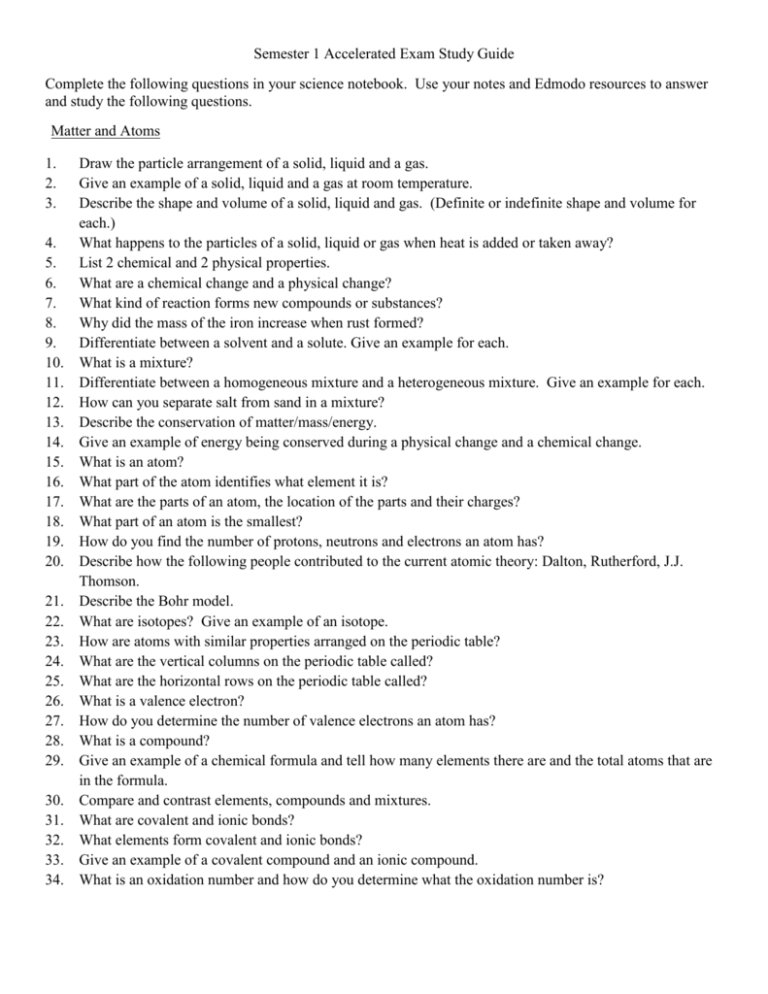
Semester 1 Accelerated Exam Study Guide Complete the following questions in your science notebook. Use your notes and Edmodo resources to answer and study the following questions. Matter and Atoms 1. 2. 3. 4. 5. 6. 7. 8. 9. 10. 11. 12. 13. 14. 15. 16. 17. 18. 19. 20. 21. 22. 23. 24. 25. 26. 27. 28. 29. 30. 31. 32. 33. 34. Draw the particle arrangement of a solid, liquid and a gas. Give an example of a solid, liquid and a gas at room temperature. Describe the shape and volume of a solid, liquid and gas. (Definite or indefinite shape and volume for each.) What happens to the particles of a solid, liquid or gas when heat is added or taken away? List 2 chemical and 2 physical properties. What are a chemical change and a physical change? What kind of reaction forms new compounds or substances? Why did the mass of the iron increase when rust formed? Differentiate between a solvent and a solute. Give an example for each. What is a mixture? Differentiate between a homogeneous mixture and a heterogeneous mixture. Give an example for each. How can you separate salt from sand in a mixture? Describe the conservation of matter/mass/energy. Give an example of energy being conserved during a physical change and a chemical change. What is an atom? What part of the atom identifies what element it is? What are the parts of an atom, the location of the parts and their charges? What part of an atom is the smallest? How do you find the number of protons, neutrons and electrons an atom has? Describe how the following people contributed to the current atomic theory: Dalton, Rutherford, J.J. Thomson. Describe the Bohr model. What are isotopes? Give an example of an isotope. How are atoms with similar properties arranged on the periodic table? What are the vertical columns on the periodic table called? What are the horizontal rows on the periodic table called? What is a valence electron? How do you determine the number of valence electrons an atom has? What is a compound? Give an example of a chemical formula and tell how many elements there are and the total atoms that are in the formula. Compare and contrast elements, compounds and mixtures. What are covalent and ionic bonds? What elements form covalent and ionic bonds? Give an example of a covalent compound and an ionic compound. What is an oxidation number and how do you determine what the oxidation number is? Forces & Motion 35. 36. 37. 38. 39. 40. 41. 42. 43. 44. 45. 46. 47. 48. 49. 50. 51. 52. 53. 54. 55. 56. 57. 58. 59. 60. 61. 62. 63. 64. 65. 66. 67. 68. 69. If you have 50 Newton’s pushing towards the right and 80 Newton’s pushing towards the left, what is the net force and in what direction would the object move? If you have 50 Newton’s pushing towards the right and 50 Newton’s pushing towards the left, what is the net force and why? Describe what makes forces balanced and what makes forces unbalanced. What is friction? How can you decrease friction? How can you increase friction? What factors determine the amount of air resistance acting on an object? Draw the picture of the following bridge forces: shear, torsion, compression, bending and tension. What is weight? (look it up) What is mass? How are mass and weight different? What happens to the force of gravity as you travel away from the earth? What happens to an object’s mass as you travel away from the earth? What two factors does the force of gravity depend upon? Give an example for each of Newton’s 3 Laws of Motion. What is Newton’s 1st law and how did it apply to the inertia cars? What is Newton’s 2nd law and how can it be applied to the inertia car activity? How does mass and force affect acceleration? If you double the mass of an object, what do you have to do to the amount of force in order to maintain the same speed? How do you solve for force, mass and acceleration using F=ma? What is Newton’s 3rd law and how does it apply to rockets? Draw an airplane and label the four forces of flight. Describe is instantaneous speed, constant speed and average speed. What is velocity and how does it differ from speed? What two variables are used to calculate speed or velocity? How do you calculate speed or velocity? How do you solve for distance and time using the formula s=d/t? What is acceleration? If acceleration is a change in velocity, then what three things can an object do to accelerate? How do you calculate acceleration? What is momentum? How do you calculate momentum? How can you increase momentum? Draw a distance time graph with 4 lines. Line 1 shows deceleration, line 2 shows an object that stopped, line 3 shows an object that is accelerating and line 4 shows an object traveling at a constant speed. How can you tell if an object started off the fastest? Explain.
